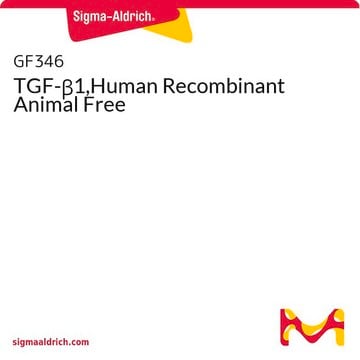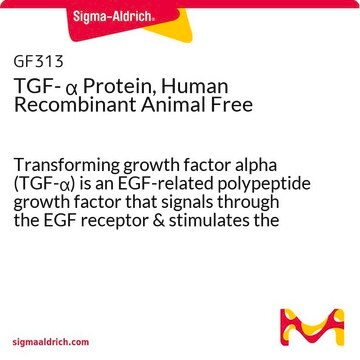616455
TGF-β1, Human, Recombinant, CHO Cell Line
Synonym(s):
rhTGF-β1, Transforming Growth Factor-β1
Sign Into View Organizational & Contract Pricing
All Photos(1)
About This Item
UNSPSC Code:
12352202
Recommended Products
assay
≥97% (SDS-PAGE)
Quality Level
form
lyophilized
manufacturer/tradename
Calbiochem®
storage condition
OK to freeze
impurities
≤1 EU/μg Endotoxin (EU/μg TGF-β1)
shipped in
ambient
storage temp.
−20°C
General description
Recombinant, human transforming growth factor-β1 expressed in CHO cells. Promotes apoptosis in resting human B lymphocytes, glioma cells, and trigeminal neurinomal cells. Induces the accumulation of extracellular matrix in various diseases.
Biochem/physiol Actions
ED₅₀ = 0.04-0.1 ng/ml
Warning
Toxicity: Standard Handling (A)
Physical form
Lyophilized from a sterile filtered solution in 50 µg BSA/µg TGF-β1, 35% acetonitrile, 0.1% TFA.
Reconstitution
Following reconstitution, aliquot and freeze (-20°C). Avoid freeze/thaw cycles of solutions. Stock solutions are stable for up to 3 months at -20°C.
Reconstitute to a concentration ≥1 µg/ml in 4 mM sterile HCl containing ≥0.1% HSA or BSA.
Other Notes
Shibuya, H., et al. 1996. Science272, 1179.
Bottlinger, E.P., et al. 1995. Proc. Natl. Acad. Sci. USA93, 5877.
Lomo, J., et al. 1995. J. Immunol.154, 1634.
Marushige, K., and Marushige, Y. 1995. Anticancer Res.14, 2419.
Yamazaki, M., et al. 1994. Am. J. Pathol. 144, 221.
Bottlinger, E.P., et al. 1995. Proc. Natl. Acad. Sci. USA93, 5877.
Lomo, J., et al. 1995. J. Immunol.154, 1634.
Marushige, K., and Marushige, Y. 1995. Anticancer Res.14, 2419.
Yamazaki, M., et al. 1994. Am. J. Pathol. 144, 221.
Legal Information
CALBIOCHEM is a registered trademark of Merck KGaA, Darmstadt, Germany
Storage Class
11 - Combustible Solids
wgk_germany
WGK 3
Certificates of Analysis (COA)
Search for Certificates of Analysis (COA) by entering the products Lot/Batch Number. Lot and Batch Numbers can be found on a product’s label following the words ‘Lot’ or ‘Batch’.
Already Own This Product?
Find documentation for the products that you have recently purchased in the Document Library.
Holly B Hindman et al.
Investigative ophthalmology & visual science, 51(4), 1935-1942 (2009-11-13)
Purpose. To characterize phenotypic differences between anterior and posterior corneal keratocytes after stimulation with the profibrotic agent transforming growth factor-beta1 (TGF-beta1) in vitro. Methods. Sixteen corneas from healthy felines were obtained immediately after death. Lamellar dissection was performed to separate
Hon Wai Koon et al.
The American journal of pathology, 177(5), 2300-2309 (2010-10-05)
Substance P (SP) and the neurokinin-1 receptor (NK-1R) are involved in the development of colitis and mucosal healing after colonic inflammation. We studied whether SP modulates colonic fibrosis by using a chronic model of trinitrobenzenesulfonic acid (TNBS)-induced colitis in wild-type
Nagat Frara et al.
Connective tissue research, 59(1), 30-44 (2017-04-13)
Transforming growth factor beta 1 (TGFbeta-1) and connective tissue growth factor (CCN2) are important mediators of tissue repair and fibrosis, with CCN2 functioning as a downstream mediator of TGFβ-1. Substance P (SP) is also linked to collagen production in tenocytes.
M Herranz-Itúrbide et al.
Redox biology, 40, 101841-101841 (2021-01-26)
Liver is a unique organ in displaying a reparative and regenerative response after acute/chronic damage or partial hepatectomy, when all the cell types must proliferate to re-establish the liver mass. The NADPH oxidase NOX4 mediates Transforming Growth Factor-beta (TGF-β) actions
Jeeranan Manokawinchoke et al.
Cell death & disease, 10(10), 761-761 (2019-10-09)
Mechanical force regulates periodontal ligament cell (PDL) behavior. However, different force types lead to distinct PDL responses. Here, we report that pretreatment with an intermittent compressive force (ICF), but not a continuous compressive force (CCF), promoted human PDL (hPDL) osteogenic
Our team of scientists has experience in all areas of research including Life Science, Material Science, Chemical Synthesis, Chromatography, Analytical and many others.
Contact Technical Service





